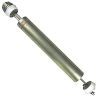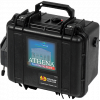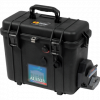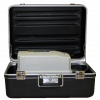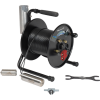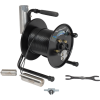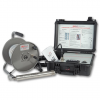You may be asking yourself, what equipment do I need for water sampling?
Given the wide array of equipment and techniques available for water sampling, there are many questions to consider when planning one of these events. This application guide is intended to help our customers determine what equipment and supplies best suit their application. If you have any questions or wish to order equipment, please contact us at (888)274-8929. Any feedback about this guide is also appreciated!
Some important questions to ask yourself when you are planning your water sampling event:
- What is the best way to collect the water sample based on well and groundwater conditions? (i.e. pump a sample to the surface, bail a sample, low flow sampling, sample down well, etc.)
- What is the well diamater? (1", 2", 4", etc.)
- How deep is the well?
- What is the depth to groundwater?
- How quickly does your well recharge?
- Does your site require a certain sampling method?
- If pumping, what pump is the best choice for the site?
- What kind of power options are available at your site?
- What supplies will you need to gather the sample?
- Disposable Groundwater Bailers
- Bailer & Pump Safety Rope
- Disposable Tubing
- Gloves, Protective Equipment
- Decontamination supplies (distilled water, 5 gallon buckets, Liquinox detergent, Alconox detergent, isopropyl alcohol, etc.)
It is important to consider the diameter of the wells at your site when choosing equipment. It may be hard to fit certain pumps or water quality instruments into wells with a small well diameter such as 1". Also, how deep is the well and what is the groundwater elevation? A water level meter can be used to find the exact depth to water inside a monitoring well. If hydrocarbons are present at the groundwater level surface, an oil/water interface probe can be used to determine the depth and thickness of the product within the well.
Shallow Wells
If the well depth and water level is fairly shallow, a peristaltic pump rental or groundwater bailer is an easy and relatively cheap option for collecting a water sample. Peristaltic Pumps use two types of tubing to take a sample. A small section of silicone tubing (generally 1-2 feet) is continuously squeezed by the pump in order to create suction. A more rigid tubing such as polyethylene tubing is coupled with the silicone tubing with hose clamps and barb fittings to go down into the well to draw the sample. Both types of tubing require a small diameter to make use of capillary forces in order to counter the head pressure generated by the water sample. The theoretical maximum depth a peristaltic pump can reach is roughly 26 feet. Peristaltic Pumps can be used in any size diameter well that the tubing can fit into (including 1" wells).
Deep Wells
For well and water depths greater than 30 feet, submersible groundwater pump rentals, intertial pump rentals, and bladder pump rentals are available. Submersible pumps generally require well diameters of 2" or greater.
12 Volt DC Submersible Pumps
Our Stainless Steel Proactive Pumps fit into 2" wells or greater and run off of 12 volt car batteries for sites that are accessible by vehicles. These pumps include the Proactive Monsoon (0-120ft), and Proactive Mega-Monsoon (0-180ft). These pumps feature easy to change motor modules and can handle fairly turbid water. The pumps hook into a controller that allows the user to adjust the flowrate of the pump by varying the voltage supplied to the pump motor. This feature is ideal for low flow sampling. The most common tubing used for these pumps is 3/8" ID X 1/2" OD Polyethylene tubing. The tubing attaches to the barb fitting on the back of the pump and is secured by a hose clamp. We advise that you use safety lines such as string or rope that attaches to a hook on the pump in order to retrieve the pump out of the well. Pulling on the motor lead wiring can cause connections issues and damage the pump.
12 Volt DC Bladder Pumps
The Geotech Bladder Pump uses bonded polyethylene tubing, a compressor, stainless steel pump housing, and a bladder to pump a sample. Water enters the pump through the inlet check valve at the bottom of the pump and fills the bladder. The compressor sends compressed air into the space between the bladder and the stainless steel housing of the pump. The inlet check valve closes and the outlet check valve at the top opens. The compressed air squeezes the bladder and forces the water out of the pump. The compressed air does not come into contact with the water sample. The pump comes in two different sizes - 0.85" and 1.66". The Geotech Bladder Pump is useful for pumping 1" wells at depths of up to 180 feet. The compressor allows you to control the flow rate and fill rate of the pump (good for low flow sampling applications). The pump is powered by a 12 volt battery pack which allows for easy use in remote locations.
120 Volt AC Submersible Pumps
We offer generator rentals for sites without power or vehicle access. The Grundfos Redi-Flo 2 and Grundfos Redi-Flo 4 are submersible pumps with high flow capability. These pumps use a variable frequency drive controller that allows for very fine tuned flow speed variation and consistency (good for low flow sampling). An electromagnet turns the rotor inside the pump which connects to a series of impellers in order to produce flow. The Redi-Flo 2 can fit into wells 2" and larger, and the Redi-Flo 4 fits into wells 4" or larger. The Redi-Flo 2 requires the use of a cooling shroud in wells larger than 2". The main drawback to these pumps is due to the high rotation speed of the rotor and pump components, silt and sediment can cause damage to the pump if not properly cleaned during sampling in these conditions. However, the amount of flow that these pumps can produce is well worth the effort! The Redi-Flo 2 rental units EEI offers come in lengths between 0-300ft, and the Redi-Flo 4 0-100ft.
120 Volt AC Intertial Pump - Well Development
For well development, we recommend the Waterra Hydrolift 2 Inertial Pump. It uses high density polyethylene tubing and a foot valve that is continuously lifted and dropped to pump water. This pump is great for well development because it can handle silts and sediment without damaging pump components. It can also be used in 1" wells. Flow rate can be adjusted by varying the speed that the tubing holder arm oscillates.
Stormwater & Wastewater Samplers
ISCO Composite/Sequential Samplers use a peristaltic pump to collect samples. The sampler can be programmed to take samples based off of time intervals or specific volumes. It can be programmed to account for tubing length and hydraulic head to make sure that the volume pumped is correct. The samples are collected in sample bottles located inside the samplers housing. ISCO Samplers can be set up for composite sampling or sequential sampling. A composite sample is taken when all of the individual samples go into the same sample bottle, creating one average sample over the entire sample period. Sequential samples are taken when each sampling event goes into a separate bottle (up to 24 bottles).

